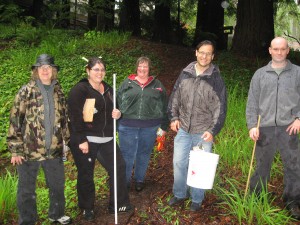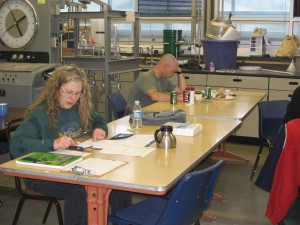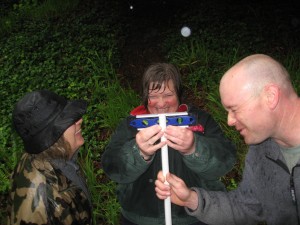05.03.09
Microhydro Institute May 2nd 2009

DYF Teachers Ellen Osten, Maggie Peter, Rebecca Schuler and Errin Odell work with Instructor Lonny Grafman to size a micro hydro system.
Overview
The first DYF Teacher Institute follow up occurred on May 2, 2009 from 8am- 4pm at Humboldt State University. Links to the materials provided at the institute are available below.
Five DYF teachers attended Ellen Osten, Maggie Peter, Rebecca Schuler, Errin Odell and Forrest Stamper. The instructors were Lonny Grafman and Beth Eschenbach of the Environmental Resources Engineering at HSU.
In the morning Beth Eschenbach reviewed the importance of increasing the number of students interested in studying STEM (Science Technology Engineering and Mathematics). Forrest Stamper and Beth Eschenbach rreflected on the successes and challenges of teaching ENGR 215 Introduction to Design at Hoopa Valley High School. (Efforts to Increase STEM in California and ENGR 215 at Hoopa Valley High School ). Other DYF teachers reported on how their teaching had changed since the DYF institute last summer. For instance, Maggie Peters brought her basket work and discussed how she teaches math, science and engineering in a culturally relevant way at Hoopa Valley Elementary School. Errin Odell shared his experiences with building bridges with manilla envelopes and using the West Point Bridge Software at Fortuna Union High School.
After reporting out, the DYF teachers completed a pre-assessment.
After the assessment, Lonny Grafman provided background information on micro hydro design, physics and math. (Microhydro basics ). The teachers learned how to use the equation below .
The teachers also learned how to use tables to calculate head loss due to friction in pipes. They calculated the difference in using 2″ pipe vs. 2-1/2″ pipe for the design of a given system. (Microhydro formula and tables for power calculation Power versus Pipe Diameter)
After lunch Lonny Grafman led the participants into the HSU forest along Jacoby Creek. The teacher participants learned how to determine the potential head in a hydro system, using simple tools such as a measureing tape, a 5 foot pipe and a level.

Ellen Osten and Errin Odell calculate head loss due to pipe friction.
After returning the the lab, the teachers discussed how they could use this lab in their own classrooms and completed a post assessment. Each participant went home with a set of materials so they could complete the lab with approximately 24 students.
Micro Hydro Field Lab Equipment Provided to Teachers (need a picture)
- 3 4-gallon buckets
- 3 stop watches (timers)
- floaters (orange peels)
- 3 meter sticks
- 3Â levels
- 3 open reel tape measures (100 ft)
- 1- 1/2″ Schedule 40 PVC pipe
- 1 – 1″ Schedule 40 PVC pipe
- 1 – 1 1/2″ Schedule 40 PVC pipe
- 1 – set of 1/2″ fittings (90, 45, T, ball gate valve, quick release, couple, check valve)
- 9 clipboards (F70M01920)
- 20 pages rainpaper (pk of 200)
Supporting materials from the day:
- Efforts to Increase STEM in California and ENGR 215 at Hoopa Valley High School (PowerPoint)
- microhydrobackground (ppt) or slideshare
- Microhydro formula and tables for power calculation (Word doc)
- Microhydro basics (Appropedia page)
- Power versus Pipe Diameter (live spreadsheet of calcs)
- Pre and post assessment questions (doc)
- Micro hydro tables and equation (d0c)
- Summary of Field Lab for Instructors
Follow-up I Goals
At the end of the workshop, teachers will:
- Understand micro-hydro systems
- Have a physical sense of friction, head, flow, power and energy
Follow-up I Objectives
At the end of the workshop, teachers will be able to:
- define micro-hydro power
- diagram the basic components of a micro-hydro system
- identify and explain the use and purpose of the basic components of a micro-hydro system
- compute the maximum and net power capacity of a specific micro-hydro system using the appropriate formula and tables
- explain the relation of pipe size to power loss
- use pipe friction tables to compute head loss
- measure head, flow and stride using buckets, timers, sticks, measuring tape and levels
- explain head and flow, and their relation to power in a micro-hydro system
- relate head, flow, power and energy in a micro-hydro system to their analogs in electrical circuits
- assess some of the pros and cons and difficulties with a micro-hydro system

Ellen Osten, Becca Schuler and Errin Odell demonstrate the use of a level for simple surveying.
Becca said,
May 12, 2009 at 4:45 pm
Lonny make the BEST vegan marshmallow taffy in the world.
Lonny said,
May 13, 2009 at 1:56 am
Thanks! It was my first time.